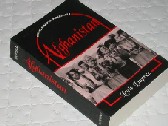afghan4 |
An
Example of a "Learning Process" Journal (using the 2 colored
box format) |
| |
September
15 , 2003 |
|
Book: Afghanistan by Louis Dupree
Source: Oxford Pakistan Paperbacks. Oxford University
Press, 1973. |
9:500 am (Monday). In the last couple of
days I have completed reading Chapter 6 (Ethnic Groups p. 57 -
65)
& Chapter 7 (Language p. 66 - 94) from Part II The People (pp.
57 - 251).
At one point while reading this morning I finally realized that
I did not know what the Moghul empire was. I had assumed it was
a local version on Mongol. I decided to check this using Google.
I am glad I did. It was an empire that occupied much of northern
and western India during the 16th and 17th century. They were considered
to be descendents of the Mongol invasion in the 13th century.
I suspect that there will be many such "facts" as I continue to
learn about this part of the planet. |
Before reading further, I want to create a few
notes for later review and reference.
- "Basically, the country is a zone of predominately Muslim,
Indo-European speakers..." (p. 55)
- "Afghanistan has been a cultural, as well as physical, melting-pot:
Persian, Central Asian, Sino-Siberian, European (Hellenistic,
Roman), Indian, Turkish, Arab, and Mongol influences rose, fell,
and blended." (p. 55)
- "Afghanistan is not a self-contained ethnic unit, and its national
culture is not uniform." (p. 57)
- Ethic Groups
- Pushtun
- Tajik
- Farsiwan
- Hazara
- Aimaq
- Moghol
- Uzbak
- Turkoman
- Kurghiz
- Baluchi
Pushtun is the largest of these, both in terms of numbers as well
as in geographic area (the south and south-eastern third of the
country). |
Chapter 7 Language
- The two principal languages are Persian (or Farsi) and Pashto.
- Farsi has several regional dialects.
- Altaic, with Turkic dialects, is spoken north of the Hindu
Kush
- Afghanistan has a literate culture, but a non-literate society
- Most Afghanis have at least a passing familiarity with the
great classical Persian poets (Rumi, Jami, Firdausi)
- "Possiby the greatest culture climax in the Afghan area occurred
during the Ghaznavid period. [around 1000] In the court of Mahmud
of Ghazni lived 400 poets and a total of 900 scholars." Firdausi
is one of the best known of these.
- "Pashto as a literature tends to get short shrift even in Afghanistan."
(p. 83)
- "The novel as found in the West is rare in the Middle East
and virtually unknown in Afghanistan." (p. 92)
- Only about 5 to 10 % of the population are literate.
|
The main point is to think of 3 dominate languages:
Pashto, Farsi and Altaic.
|
The chapter strays into a brief discussion
of religion and sufism.
- "Once a religion approaches ritual stagnation and an internal
logical or rationalistic philosophy evolves, mysticism inevitably
arises. Laymen, whether intellectuals or non-literates, often
find the monotonous regularity of the ritual and the maddeningly
simple one-two-three-four of the logic fail to yield spiritual
satisfaction. Men wish to know the Supreme Being as a personal,
not an impersonal god, but orthodoaxy usually tends to be abstract
and impersonal. In Islam a number of mystical oreders arose to
satisfy this need: the Sufi." (p. 78)
- "The Sufi orders usually did not pretend to replace orthodoxy,
but offered a way to seek the Supreme Being through personal
experience." (p. 78)
- "Sufis beleive in the oneness of man with god. ... To achieve
this momentary union with God, the Sufi must create the proper
atmosphere. Some achieve this with repeated prayers and chants;
some with artificial stimulants, including drugs; some by meditation
... some by whirling dances" (p. 80)
|
This has been helpful for me, since I would not
have been able to say anything in particular about Sufism, other
than that it exists.
11:00 am |
Reminder: each "Learning" session has a new web page.
|
